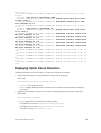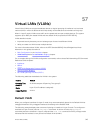
preserved as the frame moves through the network. The following example shows the structure of a
frame with a tag header. The VLAN ID is inserted in the tag header.
Figure 122. Tagged Frame Format
The tag header contains some key information that the system uses:
• The VLAN protocol identifier identifies the frame as tagged according to the IEEE 802.1Q
specifications (2 bytes).
• Tag control information (TCI) includes the VLAN ID (2 bytes total). The VLAN ID can have 4,096 values,
but two are reserved.
NOTE: The insertion of the tag header into the Ethernet frame increases the size of the frame to
more than the 1,518 bytes as specified in the IEEE 802.3 standard. Some devices that are not
compliant with IEEE 802.3 may not support the larger frame size.
Information contained in the tag header allows the system to prioritize traffic and to forward information
to ports associated with a specific VLAN ID. Tagged interfaces can belong to multiple VLANs, while
untagged interfaces can belong only to one VLAN.
Configuration Task List
This section contains the following VLAN configuration tasks.
• Creating a Port-Based VLAN (mandatory)
• Assigning Interfaces to a VLAN (optional)
• Assigning an IP Address to a VLAN (optional)
• Enabling Null VLAN as the Default VLAN
Creating a Port-Based VLAN
To configure a port-based VLAN, create the VLAN and then add physical interfaces or port channel (LAG)
interfaces to the VLAN.
NOTE: The Default VLAN (VLAN 1) is part of the system startup configuration and does not require
configuration.
A VLAN is active only if the VLAN contains interfaces and those interfaces are operationally up. As shown
in the following example, VLAN 1 is inactive because it does not contain any interfaces. The other VLANs
contain enabled interfaces and are active.
NOTE: In a VLAN, the shutdown command stops Layer 3 (routed) traffic only. Layer 2 traffic
continues to pass through the VLAN. If the VLAN is not a routed VLAN (that is, configured with an IP
address), the
shutdown command has no affect on VLAN traffic.
When you delete a VLAN (using the no interface vlan vlan-id command), any interfaces assigned
to that VLAN are assigned to the Default VLAN as untagged interfaces.
To create a port-based VLAN, use the following command.
Virtual LANs (VLANs)
915


















